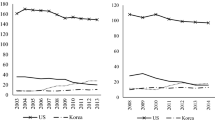Abstract
The growing influence of the idea of world-class universities and the associated phenomenon of international academic rankings are intriguing issues for contemporary comparative analyses of higher education. Although the Academic Ranking of World Universities (ARWU or the Shanghai ranking) was originally devised to assess the gap between Chinese universities and world-class universities, it has since been credited with roles in stimulating higher education change on many scales, from increasing the labor value of individual high-performing scholars to wholesale renovation of national university systems including mergers. This paper exhibits the response of the ARWU indicators and rankings to institutional mergers in general, and specifically analyses the universities of France that are engaged in a major amalgamation process motivated in part by a desire for higher international rankings.
Similar content being viewed by others
Notes
In 2014 ARWU made use of the old and new Thomson Reuters’ lists of Highly Cited Researchers to compute two HiCi sub-scores, old HiCi and new HiCi.
In the case of the HiCi indicator the equation applies to both the old and new HCR counting separately.
There are slight differences for universities specializing in social sciences and humanities where N&S is not included.
More explicitly: the rule is to count enseignants-chercheurs excluding research staff from e.g. CNRS or INSERM.
References
Aghion, P., & Cohen, E. (2004). Éducation et croissance. Paris: La Documentation française.
Alix, J. P., & Andler, M. (2013). Is the new french research and education reform going far enough? Euro Scientist. http://www.euroscientist.com.
Aula, H. M., & Tienari, J. (2011). Becoming “world-class”? Reputation-building in a university merger. Critical Perspectives in International Business, 7(1), 7–29.
Baron, M. (2010). The changes in the map of French universities since the 1960s: Findings and issues. Mouvement Social, 233, 93–105.
Billaut, J. C., Bouyssou, D., & Vincke, P. (2010). Should you believe in the Shanghai ranking: An MCDM view. Scientometrics, 84(1), 237–263.
Bourdin, J. (2008). French senate—Rapport d’information sur le défi des classements dans l’enseignement supérieur. French Senate—Session Extraordinaire de 2007–2008.
Chevaillier, T. (2013). Evaluation in French higher education: History, policy and debates. Scuola Democratica, 4(2), 619–627.
Docampo, D. (2013). Reproducibility of the Shanghai academic ranking of world universities results. Scientometrics, 94(2), 567–587.
Docampo, D., & Cram, L. (2014). On the internal dynamics of the Shanghai ranking. Scientometrics, 98(2), 1347–1366.
Docampo, D., & Cram, L. (2015). On the effects of institutional size in university classifications: The case of the Shanghai ranking. Scientometrics, 102(2), 1325–1346.
Florian, R. V. (2007). Irreproducibility of the results of the Shanghai academic ranking of world universities. Scientometrics, 72(1), 25–32.
Fridenson, P. (2010). The French higher education policy since 1968. Mouvement Social, 233, 47–67.
Hall, W. (2004). Manchester aims to be academic powerhouse. Financial Times UK, October 22, 2004.
Harman, G., & Harman, K. (2008). Strategic mergers of strong institutions to enhance comparative advantage. Higher Education Policy, 21, 99–121.
Hazelkorn, E. (2011). Rankings and the reshaping of higher education. The battle for world-class excellence. Basingstoke: Palgrave Macmillan.
HERB. (2014). Higher education in Russia and beyond, nr.1, spring 2014. Newsletter of the National Research University Higher School of Economics. http://www.ihe.hse.ru.
Hoareau, C. (2011). Globalization and dual modes of higher education policymaking in France. Centre for Studies in Higher Education, UC Berkeley, Research and Occasional Paper Series. http://escholarship.org/uc/item/9r38v416.
Labi, A. (2011). University mergers sweep across Europe. Global Chronicle of Higher Education.
Lichtenberger, Y., Macron, E., & Padis, M. O. (2007). Introduction: La réhabilitation inattendue de l’université au sein de l’enseignement supérieur. ESPRIT, 12, 9–22.
Liu, N. C., & Cheng, Y. (2005). Academic ranking of world universities: Methodologies and problems. Higher Education in Europe, 30(2), 127–136.
McBain, L. (2012). College and university mergers: An update on recent trends. American Association of State Colleges and Universities Higher Education Policy Brief.
Mérindol, J. Y. (2007). Strasbourg, l’exemple d’une fusion universitaire. ESPRIT, 12, 106–116.
Musselin, C., & Dif-Pradalier, M. (2014). When merging is clearly the best way forward: The (re)birth of the University of Strasbourg. Revue française de Sociologie, 55, 285–318.
Pisani-Ferry, J. (2014). France ten years from now—priorities for the coming decade. http://blog.en.strategie.gouv.fr/wp-content/uploads/2014/07/NS-FS-juillet2014-anglais.
Podolny, J. (2005). Status signals: A sociological study of market competition. New Jersey: Princeton University Press.
Salmi, J. (2009). The challenge of establishing world-class universities. Washington, DC: The World Bank.
Samuelson, R. (1968). French student revolt: An account of the origins and objectives. Science, 160, 971–974.
Shih, C. (2012). Towards a new golden age: Goals-challenges at King Abdullah University of Science and Technology. Ninth Annual Lecture of the Higher Education Policy Institute.
Siganos, A. (2007). French universities alliances and mergers: Impact on ARWU global rankings. http://www.shanghairanking.com/wcu/wcu2/comptitivit/mondiaux/et/Universits/EM/pour/CampusFrance.
Siganos, A. (2008). Rankings, governance, and attractiveness of higher education: The new French context. Higher Education in Europe, 33(2/3), 311–316.
SIRIS. (2011). How to speak the language of French higher education and research part 1: Translating the reforms of 2011. http://www.sirislab.com/how-to-speak-the-language-of-french-higher-education-part-1/ (downloaded 22 September 2014).
Staley, O. (2014). Nations chasing Harvard merge colleges to ascend rankings. Bloomberg, March 13.
Stephenson, S. (2011). Discursive “policy logics” of mergers in US higher education: Strategy or tragedy? Tertiary Education and Management, 17(2), 117–137.
The Ratings Game. (2010). Editorial in Nature, 464, 7–8.
Thomson Reuters. (2013). Web of knowledge v5.9 release notes. http://wokinfo.com/media/pdf/webofknowledge5-9RN.
Tight, M. (2013). Institutional churn: Institutional changes in United Kingdom higher education. Journal of Higher Education Policy and Management, 35(1), 11–20.
Van Raan, A. F. J. (2005). Fatal attraction: Conceptual and methodological problems in the ranking of universities by bibliometric methods. Scientometrics, 62(1), 133–143.
Acknowledgments
The work of D. Docampo was supported by the European Regional Development Fund (ERDF) and the Galician Regional Government under agreement for funding the Atlantic Research Center for Information and Communication Technologies (AtlantTIC).
Author information
Authors and Affiliations
Corresponding author
Rights and permissions
About this article
Cite this article
Docampo, D., Egret, D. & Cram, L. The effect of university mergers on the Shanghai ranking. Scientometrics 104, 175–191 (2015). https://doi.org/10.1007/s11192-015-1587-5
Received:
Published:
Issue Date:
DOI: https://doi.org/10.1007/s11192-015-1587-5



